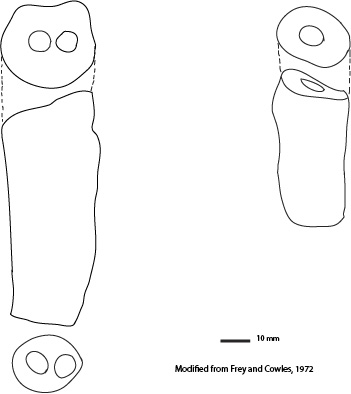Tisoa De Serres, 1840
DESCRIPTION: Two vertical tubes, cylindrical, 2 to 30 mm in diameter, about 1 to 15 mm apart, that form a long axis of nodules that can reach 1 m in length and are perpendicular to bedding. The tubes, formed within carbonate concretions, may actually branch and it is not certain whether the two tubes unite to form a “U” shaped burrow. Scratch marks are found on some walls. Single tube varieties can occur. Individual tubes are commonly lined with diagenetic pyrite, and the pairs of tubes may also have a thin layer of pyrite on the outside.
BEHAVIOR(S): Dwelling burrow
ENVIRONMENTAL SETTINGS: Marine
POSSIBLE TRACEMAKERS: shrimp or amphipod-like arthropod
GEOLOGIC RANGE: Jurassic-Oligocene
ADDITIONAL REFERENCES: Frey and Cowles, 1972; Van de Schootbrugge et al., 2010
REMARKS: Sedimentological observations, stable isotope analyses, and computer tomographic scanning, has called into question the biotic origin of Tisoa. According to van de Schootbrugge et al, 2010, tubular carbonate concretions have strongly depleted δC values and contain multiple, pyrite-filled canals, not just 2 central canals as was previously thought. This suggests that Tisoa is abiogenic in nature and was the result of authigenic carbonate deposition in sediments due to anaerobic methane oxidation and sulfate reduction. It is similar to other occurrences of subsurface conduits linked to the mobilization of fluids rich in hydrocarbons.
